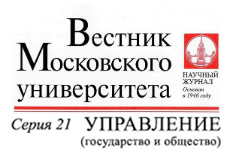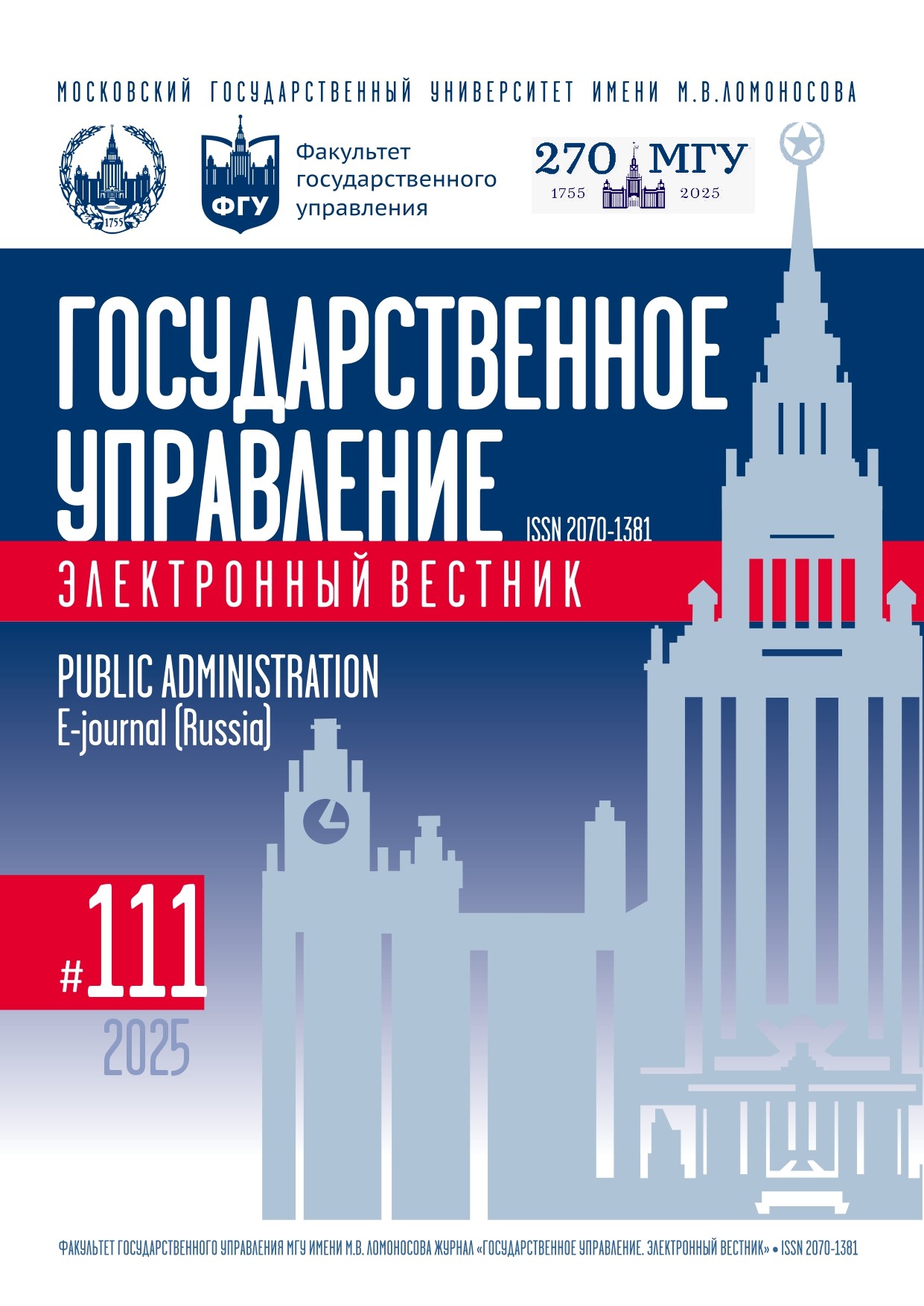Relevance of the Indicator “Quantity of Intellectual Property Assets” for Operational Management of Regional Innovation Efforts
DOI:
https://doi.org/10.55959/MSU2070-1381-111-2025-138-155Keywords:
Intellectual property, innovation, operational management, management decision, correlation and regression analysis, intellectual property objects, innovation, innovation activities at the regional level.Abstract
In order to increase the efficiency of operational management of innovative development of the subjects of the Russian Federation, it is necessary to reduce the time lag between obtaining primary statistical data and processing analytical information for government employees. The scientific research analyzed the relevance of such a primary statistical indicator as “the number of intellectual property objects of the subjects of the Russian Federation”. The relevance of the indicator was justified by formalizing the relationship between the quality of an operational management decision and time, as well as by conducting a correlation and regression analysis between the indicators “number of intellectual property objects of the subjects of the Russian Federation” and the complex indicator “rating of innovative development of the subjects of the Russian Federation”; proposals were formulated for operational management solutions that increase innovation at the regional level. To achieve the aims of the research, such scientific methods as analysis, deduction, synthesis, graphical method and statistical method were used. As a result of the research, it was found that there is a strong positive relationship between the indicators, which is confirmed by the Spearman correlation coefficient based on the rating of innovative development of the subjects of the Russian Federation for 2020 and 2023 years of publication based on statistical data for 2019 and 2021. It was also determined that the statistical significance of the data is high, which is confirmed by the coefficient of determination based on statistical data for 2019 and 2021. The interannual relationship of the data indicates a tendency towards an increase in the relationship of indicators for 2019 and 2021 years of statistical observations, which is confirmed by the Student’s criterion. In that way, the relevance of the indicator “number of intellectual property objects” for the purposes of operational management of innovation activities is high and proven. The results obtained can be used as a basis for creating an operational integral indicator of regional innovation activity and for adjusting the tools used by government officials in the field of managing the innovative development of Russian regions.
References
Абдулганиев Ф.С., Маратканова Э.М. Особенности экономики знаний и их влияние на эффективность развития инновационно-ориентированных фирм // Экономические науки. 2021. № 205. С. 220–226. DOI: 10.14451/1.205.220
Вареник М.С. Влияние научной и инновационной активности на ВРП регионов России: корреляционно-регрессионный анализ // Государственное управление. Электронный вестник. 2024. № 107. С. 171–180. DOI: 10.55959/MSU2070-1381-107-2024-171-180
Власов М.В. Оценка влияния результатов научной деятельности на инновационное развитие на региональном уровне // Вестник Пермского университета. Сер. «Экономика». 2023. Т. 18. № 1. С. 53–72. DOI: 10.17072/1994-9960-2023-1-53-72
Волкова Н.Н., Романюк Э.И. Рейтинг научно-технологического развития субъектов Российской Федерации // Вестник Института экономики Российской академии наук. 2023. № 2. С. 50–72. DOI: 10.52180/2073-6487_2023_2_50_72
Егоров Н.Е., Бабкин А.В., Васильева Н.В., Павлов Д.А. Взаимосвязь интеллектуальной и инновационной деятельности в федеральных округах Российской Федерации // Вестник Академии знаний. 2021. № 44(3). С. 99–106. DOI: 10.24412/2304-6139-2021-11220
Звягинцева О.П., Щербаков А.С. Тренды оценки человеческих ресурсов в современном цифровом пространстве // Наука и искусство управления / Вестник Института экономики, управления и права Российского государственного гуманитарного университета. 2024. № 2. С. 10–21. DOI: 10.28995/2782-2222-2024-2-10-21
Петровская Ю.А., Щекина И.В. Реализация Стратегии инновационного развития Российской Федерации до 2020 года: результаты и перспективы // Вестник НГУЭУ. 2018. № 4. С. 157–170.
Сысоева Е.В. Стратегические подходы к управлению организацией // Экономика: вчера, сегодня, завтра. 2018. Т. 8. № 10A. С. 223–233.
Chikezie P.M., Ewim A., Achumie G., Adeleke A., Okeke I., Mokogwu C. Strategic Planning and Operational Excellence: A Conceptual Model for Growth in Tech Businesses // International Journal of Engineering Research and Development. 2024. Vol. 20. Is. 11. P. 342–351.
Eberhard K. The Effects of Visualization on Judgment and Decision-Making: A Systematic Literature Review // Management Review Quarterly. 2023. Vol. 73. P. 167–214. DOI: 10.1007/s11301-021-00235-8
Fraumeni B.M. Gross Domestic Product: Are Other Measures Needed? // IZA World of Labor. 2022. DOI: 10.15185/izawol.368.v2
Han D., Fang S., Zhu H. Research on the Development Relationship between Safety Production Indicators and Economic and Social Indicators in China // Scientific Reports. 2024. Vol. 14. DOI: 10.1038/s41598-024-70945-y
Herzer D. The Impact of Domestic and Foreign R&D on TFP in Developing Countries // World Development. 2022. Vol. 151. DOI: 10.1016/j.worlddev.2021.105754
Rabhi M., Harizi R.A., Djoual M., Thamri A. Empowering Work Teams as a Mechanism to Increase the Speed of Administrative Decision-Making // International Journal of Business Information Systems. 2024. Vol. 12. Is. 2. P. 145–165.
Zakhidov G. Economic Indicators: Tools for Analyzing Market Trends and Predicting Future Performance // International Multidisciplinary Journal of Universal Scientific Prospectives. 2024. Vol. 2. P. 23–29.
Downloads
Published
Similar Articles
- Maria S. Varenik, Impact of Research and Innovative Activity on Russian Regions’ GRP: Correlation and Regression Analysis , Public Administration. E-journal (Russia): No. 107 (2024)
- Aleksandr S. Voronov, Zou Xinyu, Correlation between Scientific and Technological Achievements of Universities and Regional Innovation System in Ensuring Sustainable Economic Development at the Meso Level , Public Administration. E-journal (Russia): No. 103 (2024)
- Guzel I. Gumerova, Elmira Sh. Shaimieva, Aсtivation of Educational Organizations’ Innovative Activity in Digital Economy , Public Administration. E-journal (Russia): No. 96 (2023)
- Liubov N. Orlova, Yan Ming Jie, “Smart Specialization” Concept for Innovative Development of Russian Regions , Public Administration. E-journal (Russia): No. 102 (2024)
- Guzel I. Gumerova, S. Hüsig, G. Schewe , Aleksandra J. Butneva, Elmira Sh. Shaimieva, Formation of Organizational and Managerial Approach Based on Management of Intellectual Property Objects in the Field of International Scientific Cooperation , Public Administration. E-journal (Russia): No. 91 (2022)
- Elena S. Daniliuk, Comparison of Local Government Bodies Competence in the Republic of Belarus with Indicators for Assessing Their Effectiveness , Public Administration. E-journal (Russia): No. 87 (2021)
- Aleksandr S. Voronov, Lidiya S. Leontieva, Liubov N. Orlova, Stepan S. Sergeev, Assessment of Human Capital State at the Stage of the Sixth Technological Paradigm: Regional Aspect , Public Administration. E-journal (Russia): No. 90 (2022)
- Mikhail Y. Alekhin, Leyla E. Mamedova, Using Elements of Marginal Analysis in Managing Transformation of the Asset Structure of a Shipbuilding Enterprise , Public Administration. E-journal (Russia): No. 109 (2025)
- Alexey O. Sokolov, Indicators of Economic Feasibility of Creating Supranational Organizational and Legal Forms within the Eurasian Economic Union , Public Administration. E-journal (Russia): No. 89 (2021)
- Alexander A. Kovalenko, Developing the Model of Social Controlling of Enterprise’s Innovative Activity , Public Administration. E-journal (Russia): No. 111 (2025)
You may also start an advanced similarity search for this article.




